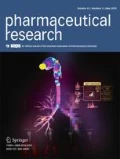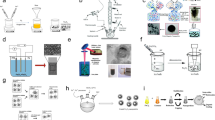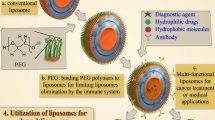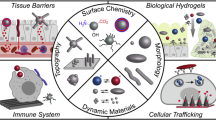Abstract
Purpose
To develop a novel docetaxel (DOC)-loaded lipid microbubbles (MBs) for achieving target therapy and overcoming the poor water-solubility drawback of DOC.
Methods
A novel DOC-loaded microbubble (DOC + MB) was prepared by lyophilization and the physicochemical properties including ultrasound contrast imaging of the liver were measured. The anti-tumor effect of the DOC + MBs combined with low-frequency ultrasound (LFUS; 0.8Hz, 2.56 W/cm2, 50% cycle duty) on the DLD-1 cancer cell line was examined using an MTT assay.
Results
The physicochemical properties of the two tested formats of DOC + MBs (1.0 mg and 1.6 mg) was shown: concentration, (6.74 ± 0.02) × 108 bubbles/mL and (8.27 ± 0.15) × 108 bubbles/mL; mean size, 3.296 ± 0.004 μm and 3.387 ± 0.005 μm; pH value, 6.67 ± 0.11 and 6.56 ± 0.05; release rate, 3.41% and 12.50%; Zeta potential, −37.95 ± 7.84 mV and −44.35 ± 8.70 mV; and encapsulation efficiency, 54.9 ± 6.21% and 46.3 ± 5.69%, respectively. Compared with SonoVue, the DOC + MBs similarly enhanced the echo signal of the liver imaging. The anti-tumor effect of the DOC + MBs/LFUS group was significantly better than that of DOC alone and that of the normal MBs/LFUS groups.
Conclusions
The self-made DOC + MBs have potential as a new ultrasound contrast agent and drug-loaded microbubble, and can obviously enhance the antitumor effect of DOC under LFUS exposure.








Similar content being viewed by others
Abbreviations
- DOC:
-
docetaxel
- DOC + MB:
-
docetaxel-loaded microbubble
- IR:
-
inhibitory rate
- LFUS:
-
low-frequency ultrasound
- MB:
-
microbubble
- NMB:
-
normal microbubble
- NS:
-
normal saline
- PTX:
-
paclitaxel
- PBS:
-
phosphate buffer saline
- RP-HPLC:
-
reverse-phase liquid chromatography
- TtoPk:
-
time to peak
- TIC:
-
time intensity curve
- UCA:
-
ultrasound contrast agent
- US:
-
ultrasound
References
Zhao P, Dai M, Chen W, Li N. Cancer trends in China. Jpn J Clin Oncol. 2010;40(4):281–5.
Baeuerle PA, Itin C. Clinical experience with gene therapy and bispecific antibodies for T cell-based therapy of cancer. Curr Pharm Biotechnol. 2012;13(8):1399–408.
Anwer K, Kao G, Proctor B, Anscombe I, Florack V, Earls R, et al. Ultrasound enhancement of cationic lipid-mediated gene transfer to primary tumors following systemic administration. Gene Ther. 2000;7(21):1833–9.
Yan F, Li X, Jin Q, Jiang C, Zhang Z, Ling T, et al. Therapeutic ultrasonic microbubbles carrying paclitaxel and LyP-1 peptide: preparation, characterization and application to ultrasound-assisted chemotherapy in breast cancer cells. Ultrasound Med Biol. 2011;37(5):768–79.
Kang J, Wu X, Wang Z, Ran H, Xu C, Wu J, et al. Antitumor effect of docetaxel-loaded lipid microbubbles combined with ultrasound-targeted microbubble activation on VX2 rabbit liver tumors. J Ultrasound Med. 2010;29(1):61–70.
Waite CL, Roth CM. Nanoscale drug delivery systems for enhanced drug penetration into solid tumors: current progress and opportunities. Crit Rev Biomed Eng. 2012;40(1):21–41.
Guarneri V, Dieci MV, Conte P. Enhancing intracellular taxane delivery: current role and perspectives of nanoparticle albumin-bound paclitaxel in the treatment of advanced breast cancer. Expert Opin Pharmacother. 2012;13(3):395–406.
Collins-Gold L, Lyons R, Bartholow L. Parenteral emulsions for drug delivery. Adv Drug Deliv Rev. 1990;5(3):189–208.
Harris JD, Gutierrez AA, Hurst HC, Sikora K, Lemoine NR. Gene therapy for cancer using tumour-specific prodrug activation. Gene Ther. 1994;1(3):170–5.
Kato T, Sato K, Sasaki R, Kakinuma H, Moriyama M. Targeted cancer chemotherapy with arterial microcapsule chemoembolization: review of 1013 patients. Cancer Chemother Pharmacol. 1996;37(4):289–96.
Luo G, Yu X, Jin C, Yang F, Fu D, Long J, et al. LyP-1-conjugated nanoparticles for targeting drug delivery to lymphatic metastatic tumors. Int J Pharm. 2010;385(1–2):150–6.
O’Shaughnessy JA. Pegylated liposomal doxorubicin in the treatment of breast cancer. Clin Breast Cancer. 2003;4(5):318–28.
Park JW. Liposome-based drug delivery in breast cancer treatment. Breast Cancer Res. 2002;4(3):95–9.
Schutt EG, Klein DH, Mattrey RM, Riess JG. Injectable microbubbles as contrast agents for diagnostic ultrasound imaging: the key role of perfluorochemicals. Angew Chem Int Ed. 2003;42(28):3218–35.
Tartis MS, McCallan J, Lum AFH, LaBell R, Stieger SM, Matsunaga TO, et al. Therapeutic effects of paclitaxel-containing ultrasound contrast agents. Ultrasound Med Biol. 2006;32(11):1771–80.
Zhou X, Qin H, Li J, Wang B, Wang C, Liu Y, et al. Platelet-targeted microbubbles inhibit re-occlusion after thrombolysis with transcutaneous ultrasound and microbubbles. Ultrasonics. 2011;51(3):270–4.
Lentacker I, De Smedt SC, Sanders NN. Drug loaded microbubble design for ultrasound triggered delivery. Soft Matter. 2009;5(11):2161–70.
Barnett S. Nonthermal issues: cavitation–its nature, detection and measurement. Ultrasound Med Biol. 1998;24:S11–21.
Liu Y, Miyoshi H, Nakamura M. Encapsulated ultrasound microbubbles: therapeutic application in drug/gene delivery. J Control Release. 2006;114(1):89–99.
Engels FK, Mathot RAA, Verweij J. Alternative drug formulations of docetaxel: a review. Anti Cancer Drugs. 2007;18(2):95.
Frenkel PA, Chen S, Thai T, Shohet RV, Grayburn PA. DNA-loaded albumin microbubbles enhance ultrasound-mediated transfection in vitro. Ultrasound Med Biol. 2002;28(6):817–22.
Michaud LB, Valero V, Hortobagyi G. Risks and benefits of taxanes in breast and ovarian cancer. Drug Saf. 2000;23(5):401–28.
Rowinsky EK, Donehower RC. Paclitaxel (taxol). N Engl J Med. 1995;332(15):1004.
Cortes JE, Pazdur R. Docetaxel. J Clin Oncol. 1995;13(10):2643–55.
Sanli UA, Uslu R, Karabulut B, Sezgin C, Saydam G, Omay SB, et al. Which dosing scheme is suitable for the taxanes? An in vitro model. Arch Pharm Res. 2002;25(4):550–5.
Ren ST, Zhang H, Wang YW, Jing BB, Li YX, Liao YR, et al. The preparation of a new self-made microbubble-loading urokinase and its thrombolysis combined with low-frequency ultrasound in vitro. Ultrasound Med Biol. 2011;37(11):1828–37.
Schneider M. Characteristics of SonoVuetrade mark. Echocardiography. 1999;16(7, Pt 2):743–6.
Sirsi S, Borden M. Microbubble compositions, properties and biomedical applications. Bubble Sci Eng Technol. 2009;1(1–2):3–17.
Duncan PB, Needham D. Test of the Epstein-Plesset model for gas microparticle dissolution in aqueous media: effect of surface tension and gas undersaturation in solution. Langmuir. 2004;20(7):2567–78.
Unger EC, McCreery TP, Sweitzer RH, Caldwell VE, Wu Y. Acoustically active lipospheres containing paclitaxel: a new therapeutic ultrasound contrast agent. Invest Radiol. 1998;33(12):886–92.
Cochran MC, Eisenbrey J, Ouma RO, Soulen M, Wheatley MA. Doxorubicin and paclitaxel loaded microbubbles for ultrasound triggered drug delivery. Int J Pharm. 2011;414(1–2):161–70.
Tinkov S, Bekeredjian R, Winter G, Coester C. Microbubbles as ultrasound triggered drug carriers. J Pharm Sci. 2009;98(6):1935–61.
Talu E, Hettiarachchi K, Zhao S, Powell RL, Lee AP, Longo ML, et al. Tailoring the size distribution of ultrasound contrast agents: possible method for improving sensitivity in molecular imaging. Mol Imaging. 2007;6(6):384–92.
Phillips LC, Klibanov AL, Wamhoff BR, Hossack JA, editors. Ultrasound-microbubble-mediated drug delivery efficacy and cell viability depend on microbubble radius and ultrasound frequency 2010: IEEE International Ultrasonics Symposium Proceedings.
Klibanov AL. Preparation of targeted microbubbles: ultrasound contrast agents for molecular imaging. Med Biol Eng Comput. 2009;47(8):875–82.
Fisher NG, Christiansen JP, Klibanov A, Taylor RP, Kaul S, Lindner JR. Influence of microbubble surface charge on capillary transit and myocardial contrast enhancement. J Am Coll Cardiol. 2002;40(4):811–9.
Wang B, Wang L, Zhou XB, Liu YM, Wang M, Qin H, et al. Thrombolysis effect of a novel targeted microbubble with low-frequency ultrasound in vivo. Thromb Haemost. 2008;100(2):356–61.
Daffertshofer M, Gass A, Ringleb P, Sitzer M, Sliwka U, Els T, et al. Transcranial low-frequency ultrasound-mediated thrombolysis in brain ischemia: increased risk of hemorrhage with combined ultrasound and tissue plasminogen activator: results of a phase II clinical trial. Stroke. 2005;36(7):1441–6.
Jenne JW, Preusser T, Gunther M. High-intensity focused ultrasound: principles, therapy guidance, simulations and applications. Z Med Phys. 2012 Aug 9.
Feril Jr LB, Kondo T. Biological effects of low intensity ultrasound: the mechanism involved, and its implications on therapy and on biosafety of ultrasound. J Radiat Res. 2004;45(4):479–89.
Feril Jr LB, Kondo T. Major factors involved in the inhibition of ultrasound-induced free radical production and cell killing by pre-sonication incubation or by high cell density. Ultrason Sonochem. 2005;12(5):353–7.
Tachibana K, Feril Jr LB, Ikeda-Dantsuji Y. Sonodynamic therapy. Ultrasonics. 2008;48(4):253–9.
Acknowledgments and Disclosures
The authors would like to thank Hua-Sheng Liu, Ph.D. and Jiang-Wei Liang for helps in the experiment. The present study was supported by the Scientific Technology Planning Foundation of Shaanxi Province (No.2010K12-01, 2011K12-56), Province Ministry Graveness Engineering Program (No.2009ZDKG-20; No.2008ZDKG-60, 2007ZDKG-290).
Author information
Authors and Affiliations
Corresponding author
Additional information
Shu-Ting Ren and Yi-Ran Liao contributed equally to this work.
Rights and permissions
About this article
Cite this article
Ren, ST., Liao, YR., Kang, XN. et al. The Antitumor Effect of a New Docetaxel-Loaded Microbubble Combined with Low-Frequency Ultrasound In Vitro: Preparation and Parameter Analysis. Pharm Res 30, 1574–1585 (2013). https://doi.org/10.1007/s11095-013-0996-5
Received:
Accepted:
Published:
Issue Date:
DOI: https://doi.org/10.1007/s11095-013-0996-5




